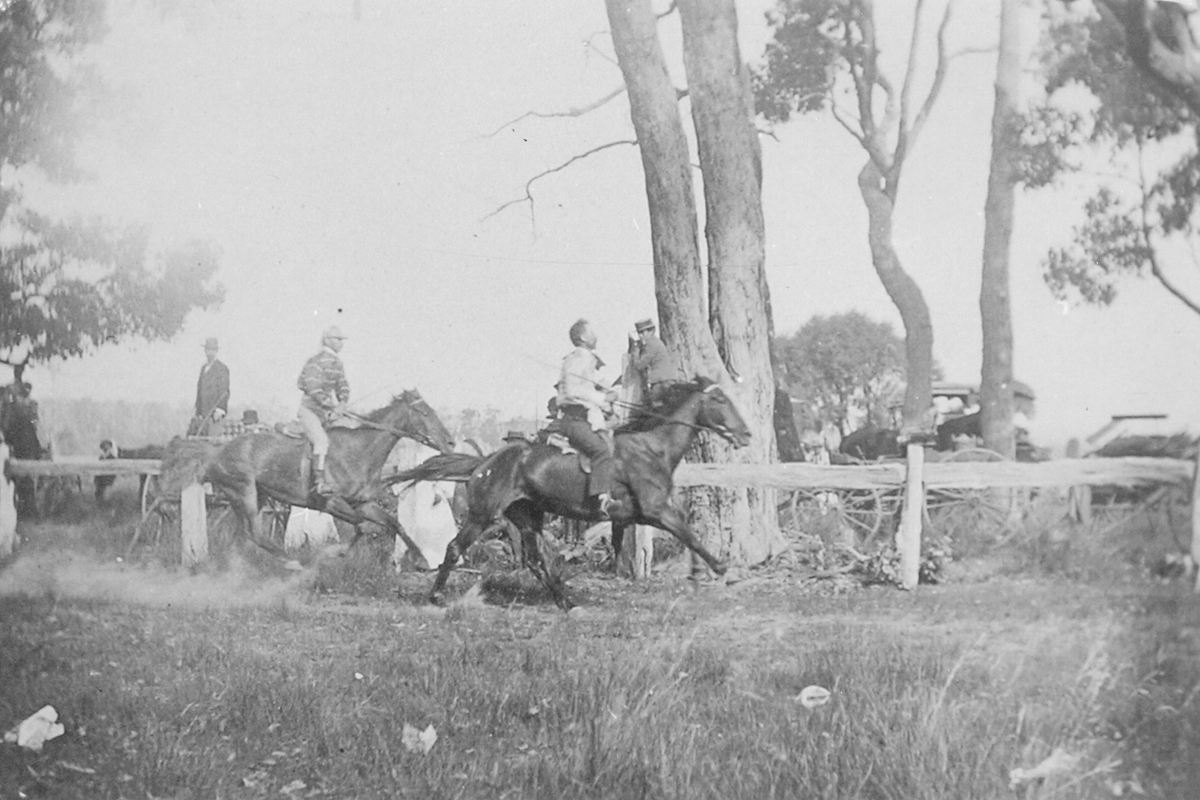
Last year, the Balnarring Picnic Racing Club celebrated the 160th anniversary of popular Emu Plains Racecourse. Although the club has had five different names during the journey, the location at Emu Plains has remained the same.
The need for a course
Early in 1860 John Buckley owned a draught mare named “Kathleen”.
This mare was noted for her speed and challenges were frequently sent out to local residents. “Who could catch John Buckley on ‘Kathleen’?”.
A tract of country near Bittern called the Emu Plains was situated between Hastings and Balnarring and, being accessible for residents of both townships, was set aside as a reserve.
Many local horse owners accepted the challenge to race against “Kathleen” and a racecourse was laid out there.
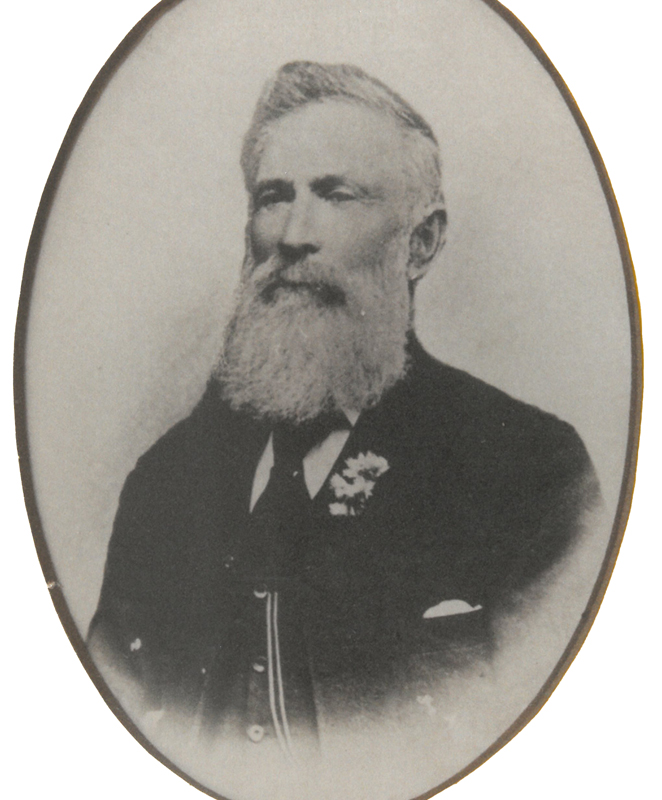
John Buckley Snr
The Hastings and Balnarring Racing Club, founded in 1863
A Boxing Day picnic event was arranged and those who owned gallopers attended to challenge “Kathleen”. The “picnics” became a recognised outing, and the men would buy new moleskin trousers for the annual Hastings and Balnarring Racing Club Boxing Day meeting.
President of that first era was Mr Peddle with Matthew Unthank as secretary. Stewards were drawn from the Committee and on Boxing Day 1881 were treasurer D. Mairs JP; judge A. Downward JP; starter M. Unthank; clerk of course F. Peddle; clerk of scales H. Prosser; handicappers T. Mairs, G. Stuart, M. Unthank, P. Kennedy and J. S. Adams.
The Mairs family owned all the land from Coolart to Western Park and Hann’s Inlet. Harry Prosser was the owner of the Hastings General Store and the others all property owners from Merricks, Balnarring and Hastings.
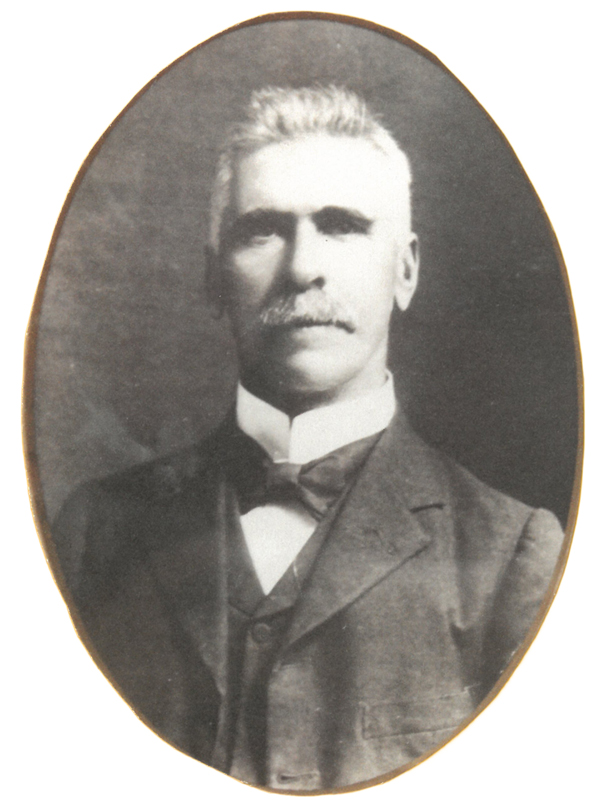
Alfred Downward MLA
Following a petition by ratepayers to the Department of Crown Lands and Survey in July 1877, the race track was officially reserved for public recreation purposes in January 1878. Trustees of the Emu Plains Racecourse appointed in 1879 and 1880 were Alfred Downward, M.L.A., John Buckley Snr., Henry H. Peddle, Henry Prosser and David Mairs, together with Paul VanSuylen, these gentlemen formed the first Committee of Management.
The 1889 Boxing Day Emu Plains meeting was the largest ever to date, with an estimated attendance of 1200. The greatest surprise was where did the people come from? The day was exceedingly hot with a strong northerly wind and immense clouds of dust. The supply of vehicles was insufficient to carry the numbers that arrived by steam train, and many employed Shanks’ pony for the long walk from the station.
By this time, the type “Kathleen” represented had become outdated and her place taken by smaller and more classy horses and ponies. A pony owned by J. Johnson, “Annie Rooney”, was considered unbeatable and eventually raced in Melbourne where she won race after race. Sadly, she was finally barred by the bookies!
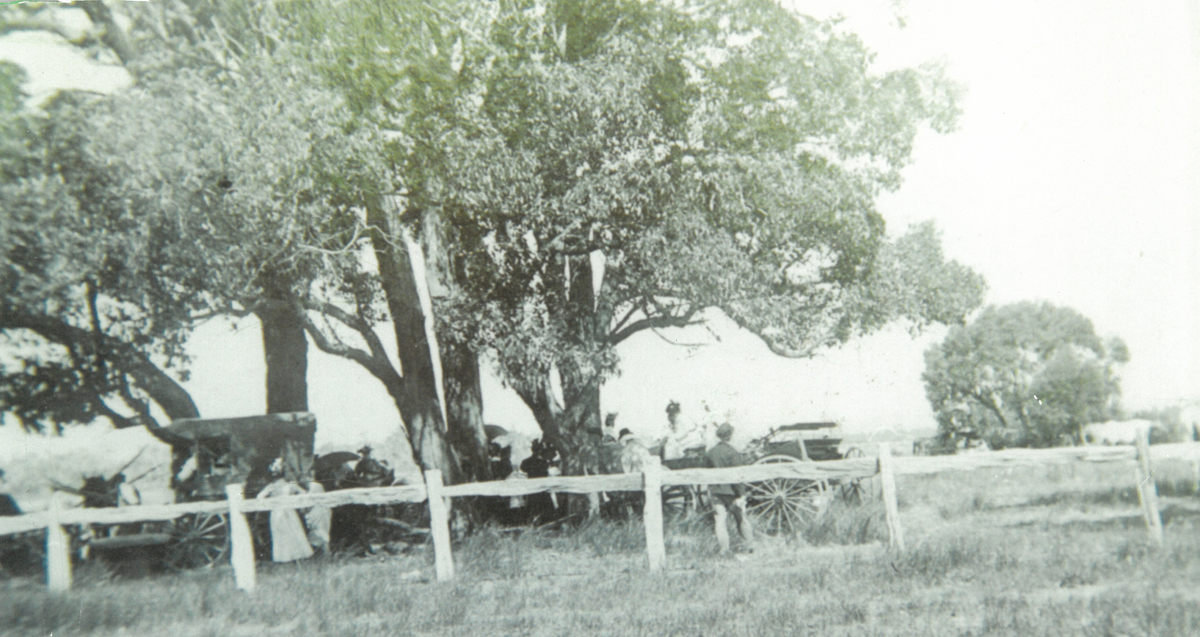
Balnarring Racecourse 27 December 1897
A change of name
The inaugural meeting of the newly formed Balnarring and Bittern Amateur Racing Club was held on the Emu Plains Racecourse on the Queen’s Birthday, 25 May 1891. It was attended by a large gathering and favoured by perfect weather.
At the Easter Monday meeting in 1898 the stewards were A. Downward M.L.A., W. Hurley, M. Myers, J. C. Griffiths, J. Turner, F. Foster, T. O’Reilly, J. Connell, C. Graves jnr., J. Johnson, W. Gomm, J. Meehan, L. Clauscen, K. Turner, D. Buckley, R. Stanley, M. P. Davey, J. Shand, G. Riley and H. Unthank.
Another name change
The Balnarring Racing Club was created by an amalgamation of the previously mentioned two clubs, and Dave Buckley became secretary of the united clubs. In the 1900s there continued to be large attendances and many families used the race meeting as a picnic day to meet with friends from Melbourne and from the new areas along the South Gippsland Ranges.
In October 1907 attempts were made to re-establish the Balnarring and Bittern Racing Club which had lapsed some years prior. Of the four original trustees appointed 15 years earlier only two were still alive.
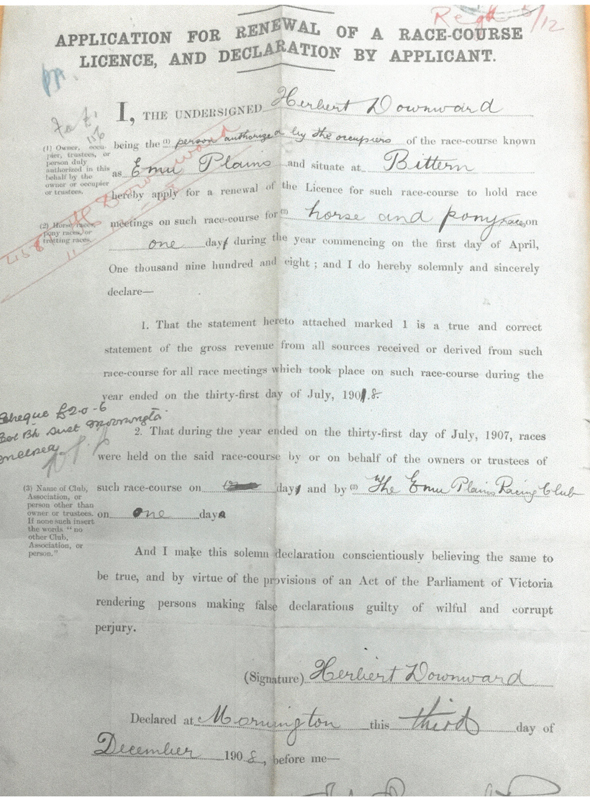
Application for renewal of a racecourse licence 1908
And yet another!
In 1907 and 1908 John Davies was elected president of Emu Plains Racing Club and it was decided to conduct a working bee in the first week of December to put the course in order, and to hold a dance at the Balnarring Hall that evening. The White brothers offered to disc the track with their new plough.
In 1909 a committee was established to find a suitable site for a cemetery at Balnarring. On 28 May 1909, The Age reported that ten acres of the Emu Plains Reserve was being sought for this purpose. This proposal was strongly opposed by the horse racing fraternity and the “cemetery for Balnarring” project appears to have been buried for eternity.
With the development of the Crib Point Naval Base, HMAS Cerberus, in 1921, a new membership was attracted, and the club and the navy have always had a good relationship. At this time the running rail consisted of unbarked saplings laid in the forks of other saplings; the whole distance being only the length of the straight. The rest of the track was marked with sticks, each carrying a small red flag and 56 yards (51.2 metres) apart.
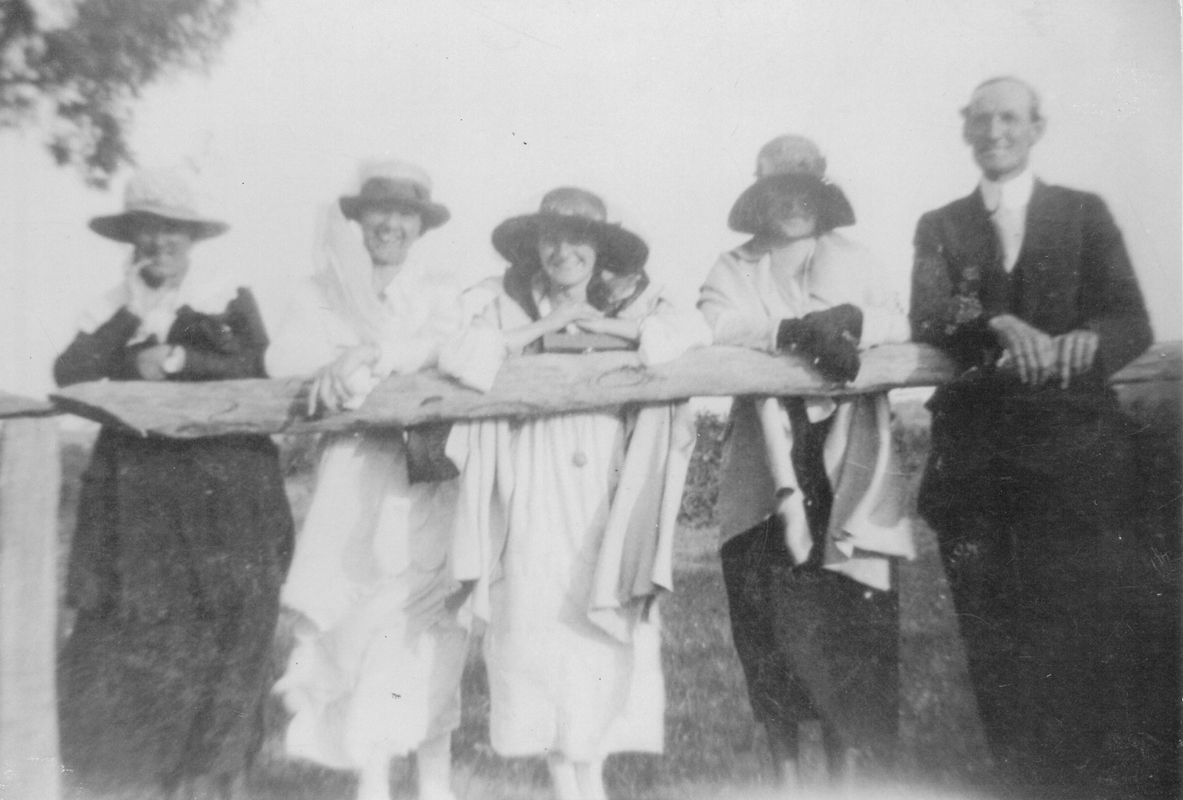
Racing enthusiasts, 1920
It took another ten years to complete construction of the nine furlongs with the running rail. The number of horses increased causing an issue with control and financial reserves were called upon in order to accommodate horses in open air stalls.
In 1928, Jack O’Connor and Herbert Downward won the day for the club’s affiliation with the VRC, and were elected joint secretaries. President was E. Hope Campbell who fired enthusiasm for the first registered meeting with liquid refreshments. The Depression was looming and the profits of the club were becoming unwanted losses. In an attempt to protect the sport, the government of the day decided on a reform programme to de-licence about 50 clubs. The club was in debt and a “Wind-up smoke night for the Bittern Racing Club” was held at the Royal Hotel in Hastings on 12 October 1933. The club meeting was staged with regret as the club was now prevented from holding VRC meetings.
Herbert Downward and Jack O’Connor called on the minister to exempt the club and to allow amateur meetings, trots and gallops, with amateur horsemen.
A final change to its present name
On ANA day 1933 the “club of many titles” was reborn as the Balnarring Picnic Racing Club, with Dick Audley as its first president. The first secretary was James Cavanagh, followed by Jack Wallace, Leslie Cavanagh, Norman Richardson (and after his death his wife, Gladys Richardson) and Robert (Bob) Norris. Gladys Richardson was only the second woman in Victoria to act as secretary of such a club.
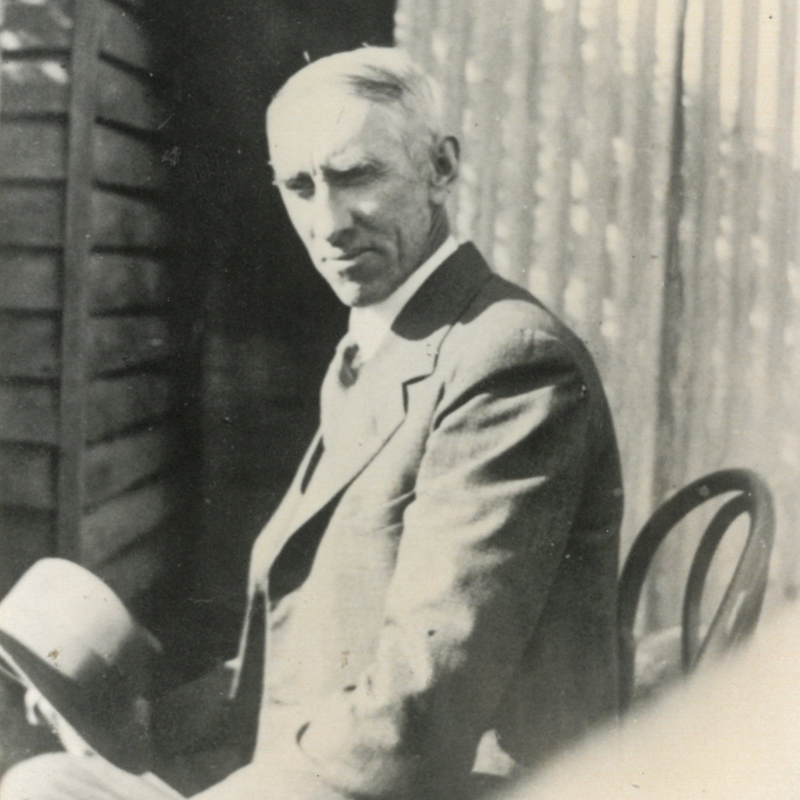
Herbert Downward
James Cavanagh recalls race days when his dad was on the gate, his mum was selling sandwiches and hot water, while he kept the boiler going with logs he chopped. Vic Ford and Jack Wallace were trustees and also active workers. The Staceys in the Bittern Store were paid by the bookmakers to keep the telephone operating on Sunday so Melbourne bookmakers could keep in touch. It was a happy picnic atmosphere, usually hot and there was no bar in those early days. Crowds were large and the event seemed more like a gymkhana. The Stacey boys travelled from Bittern on their donkey to get there.
During the two world wars the armed services found the reserve most useful for camps and exercises.
The committee of 1944 was: president R. Audley; vice-president C. Temby; committee H. Butt, J. Buckley, R. Neville, J. Glover, H. Glover, B. Cook, E. Byrne, W. Worlod, R. Horwood, G. Turner, J. Meehan, H. Cavanagh, C. Beard, H. Downward, J. Noonan, B. Cannard, J. Wallace, C. Henderson, R. J. Horwood, R. M. Ansett and W. Shartand.
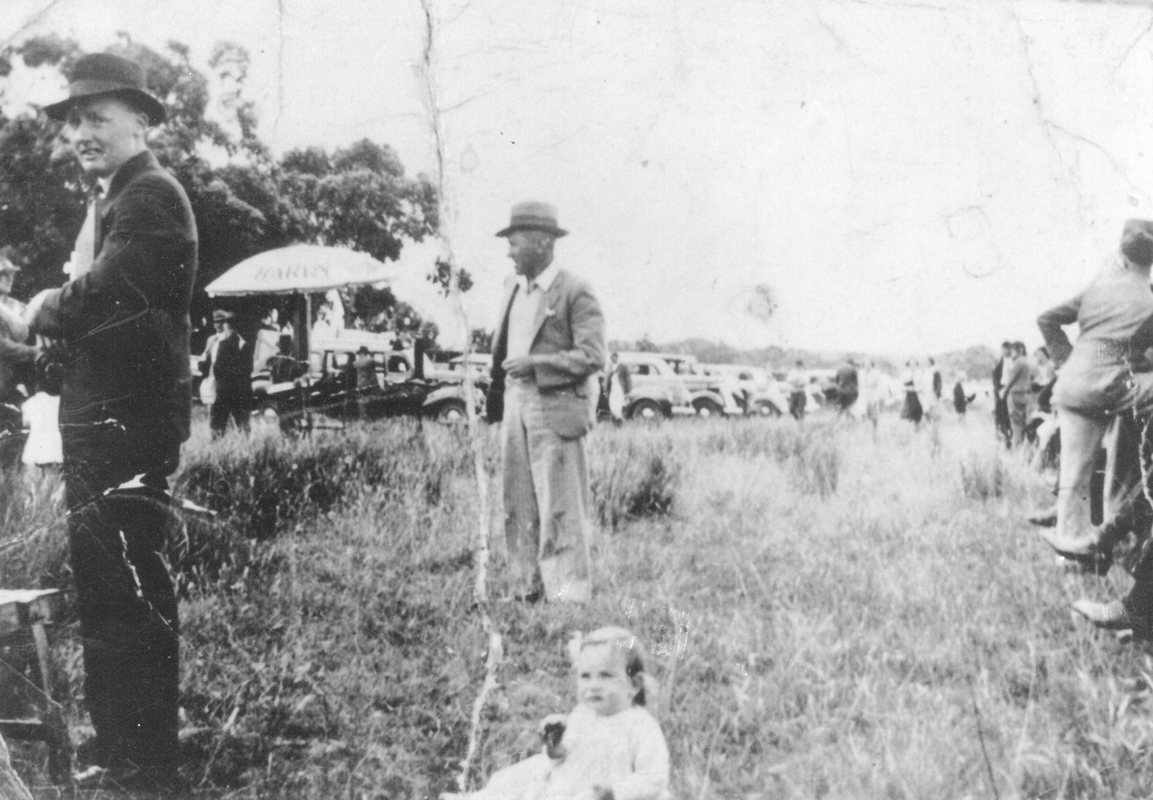
The races, circa 1940’s
Post World War Two
With the resumption of racing after the Second World War, the first revamped Balnarring Cup took place in November 1948. The race was run of eight furlongs (1600 metres) and was won by “Helenette”, owned by Lou Abrahams of Tongala Stud Red Hill South, trained by Norm Francis and ridden by Norm McDonell, who is still with us today. Norm was awarded Life Membership of the club in 2022.
Lou Abrahams had donated a canteen of cutlery as the trophy for the winner, and the then President Sam Ramsay had great delight in presenting the trophy back to Lou Abrahams.
By the 1950’s the club had continued to grow and, with the assistance of volunteers, improved the drainage around the track to present a better racing surface. The club continued to be a popular venue with racegoers and large crowds were attracted to the meetings.
In the early 1960’s electricity was brought in, a bore was sunk to provide water to maintain the track, Mornington Racing Club donated a judges box, and more horse stalls were added.
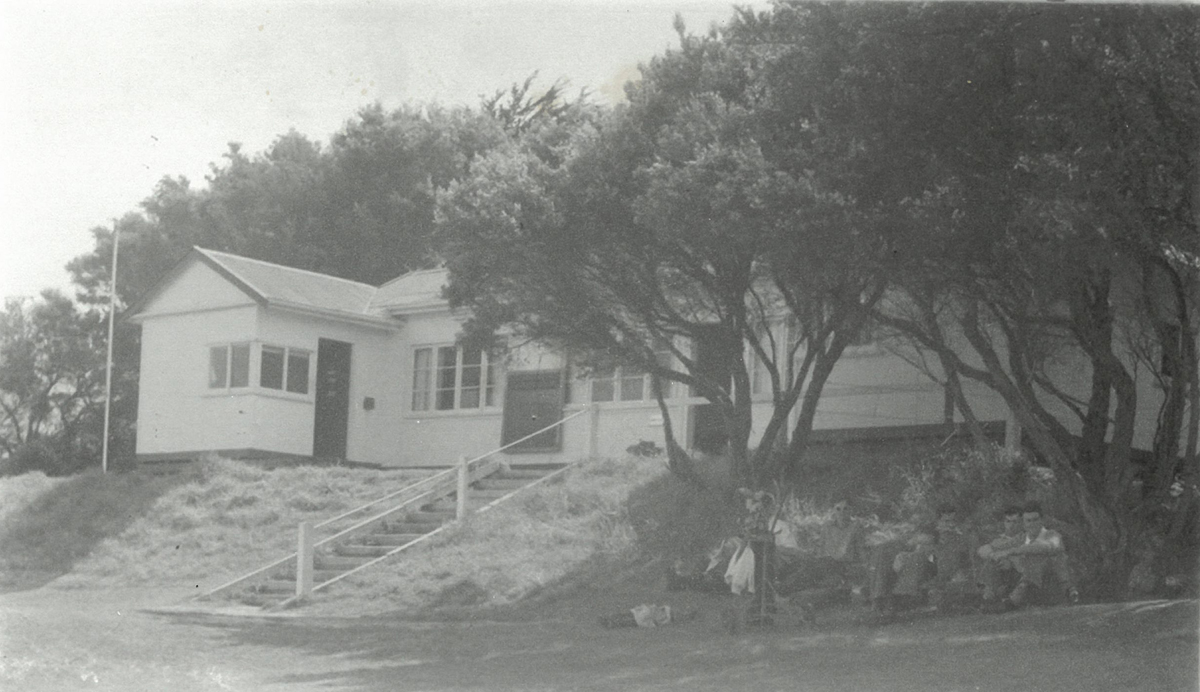
Flinders Golf Clubhouse
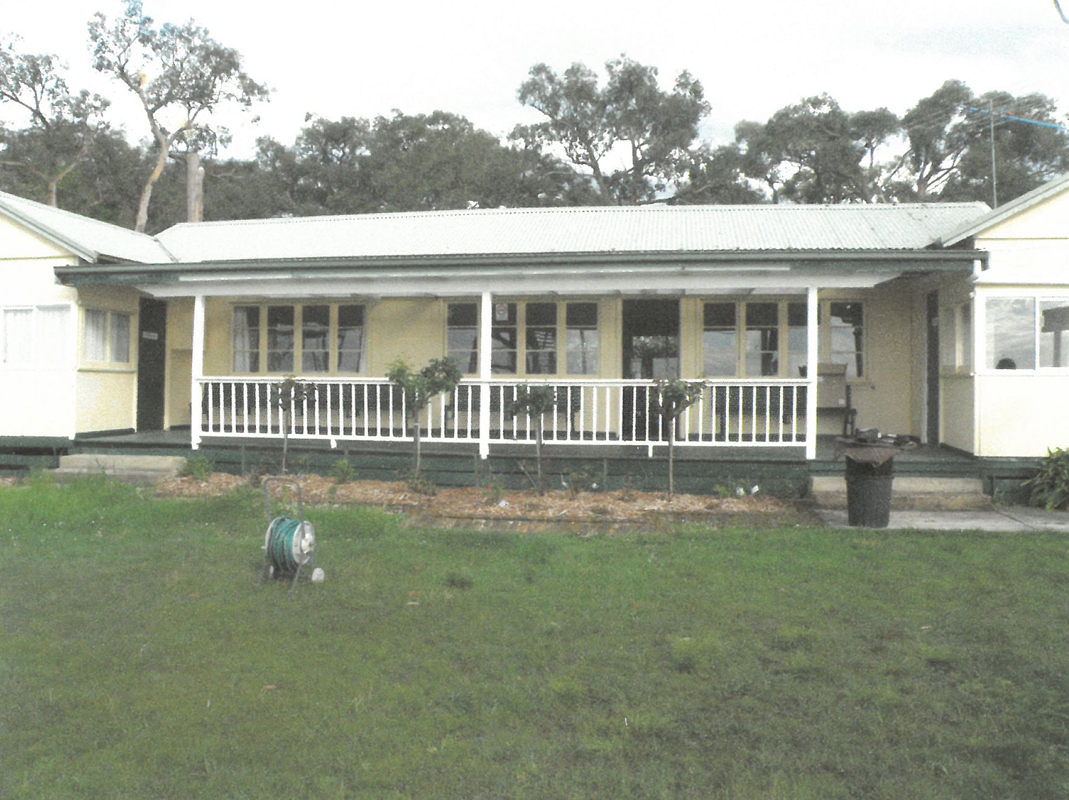
The Clubhouse at Emu Plains today
Arrival of the Clubhouse
The Clubhouse began life as the officers living quarters at the Balcombe Army Camp at Mt Martha. It was built in 1942 when the camp was receiving US Marines who had been at Guadalcanal.
The Marines used the Balcombe Camp for rehabilitation and recuperation until their departure some months later.
In the mid 1950’s the building was acquired by the Flinders Golf Club and moved to Flinders to become the Clubhouse.
In 1963 the building was again looking for a new home. The building was offered for tender and a special committee from the racing club went to inspect the premises. The deal was done and the building was moved to its new home at Emu Plains. Some alterations and improvements have taken place and 60 years after its move the Clubhouse is still in use today.
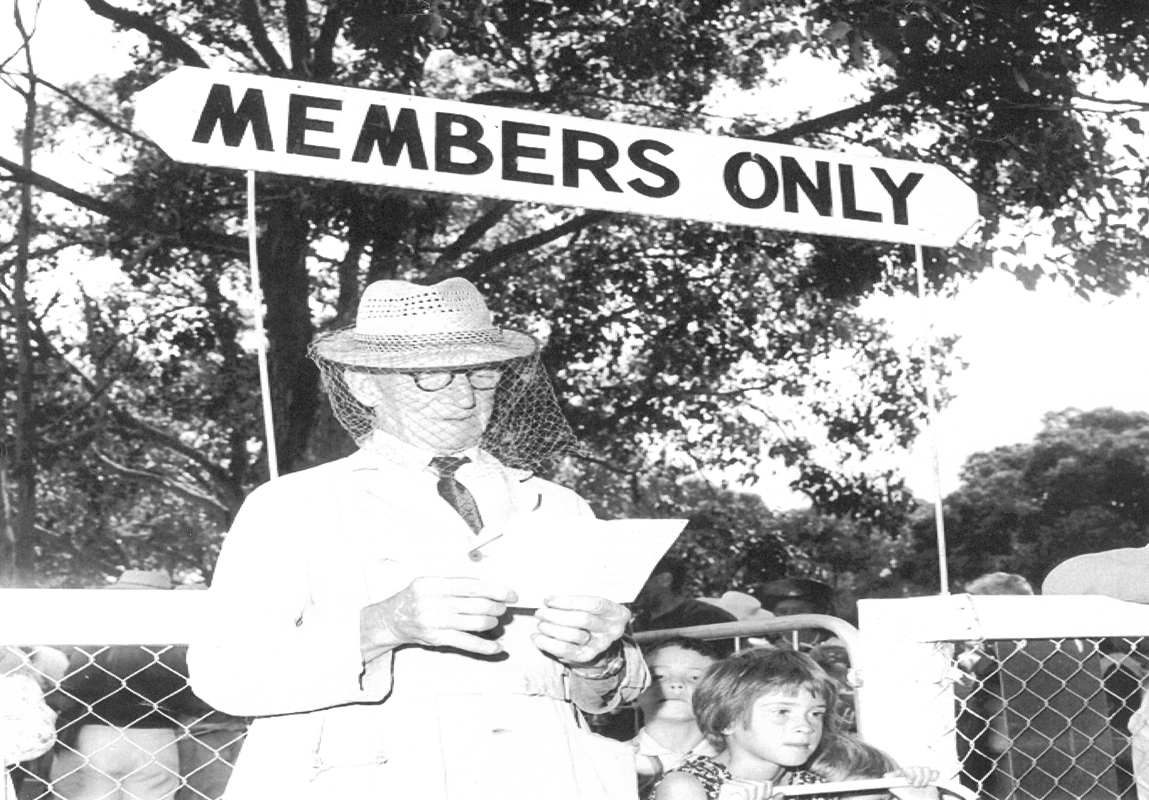
Entrance to the members area
Recent developments
Through the 1970’s and 1980’s the club continued to grow and attracted large crowds which resulted in extra meetings being added to the programme. Four meetings a year were now held over the summer period and holiday makers on the Mornington Peninsula flocked to the races.
At this time new facilities were added; toilet blocks, catering facilities and a new set of starting stalls.
During the 1980’s the course was altered slightly to incorporate a chute to allow races over eight furlongs (1600 metres).
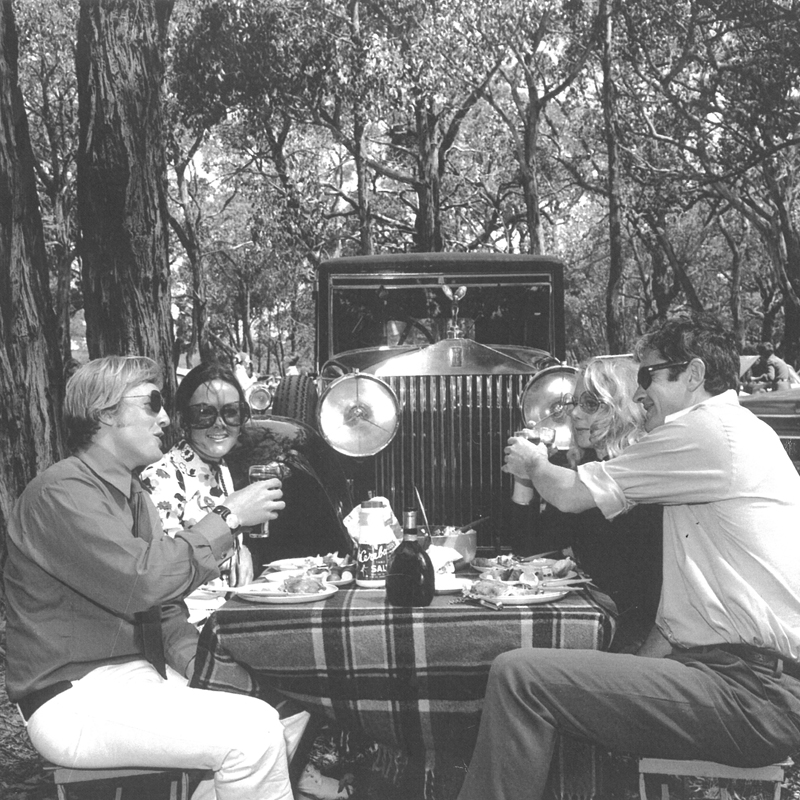
The 1990’s presented a challenging time for the club with many alternate leisure activities affecting attendance at the races. Work was needed to attract people back to the “Picnics” and this occurred when Peter Spyker became President and Neil Heathcote was Secretary.
With the assistance of the hard working committee, facilities at the course were improved and racegoers returned. In this time OH&S became an issue. The outside running rail was installed where previously there was nothing, barrier stalls were made safer and the public kept at a safe distance on race days.

Socialising at Emu Plains
Other improvements made at this time included the demolition of the caretaker’s residence which was replaced by a new toilet block for members. A children’s playground was installed and toilet facilities in the public area were upgraded.
The betting ring and members’ enclosure were sealed and shade sails installed to provide shelter from the weather.
Recent upgrades to the Clubrooms include installation of a large glass sliding door to the verandah and air conditioning.
An automatic watering system went in during 2021 and this has reduced the amount of manual labour needed to water the track. The inside and outside running rails were replaced with lightweight plastic rail, adding another safety feature.
Many top trainers have had numerous winners at the course; Jim Houlahan, George Hanlon, Bob Maxwell, Tom Harrison, Charlie Waymouth and Tom Alderson are just a few who have succeeded.
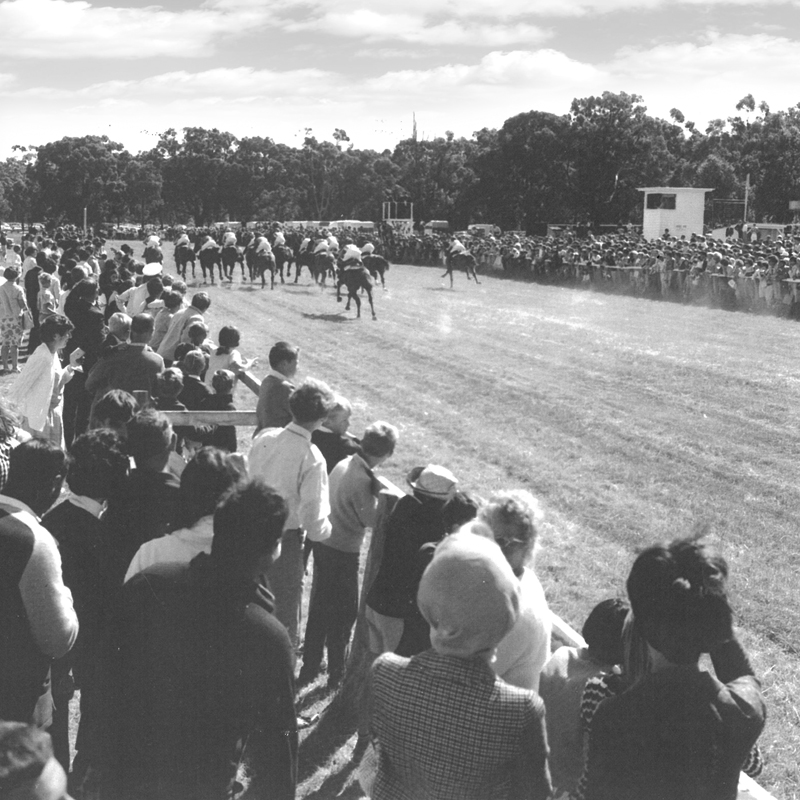
And they’re off!
Great riders at Balnarring over the years have included Bruce Purcell, Robert Waymouth, Adam Bodey, the late Bobby Armstrong, Gary Hanlon, Stan Kerr, Fran Houlahan, Debbie Waymouth, Gavin Brady and Ray Douglas.
In the 160th anniversary of the club the weather was unkind forcing the abandonment of the first two meetings for the season late in 2022. The club bounced back and conducted two bumper meetings in January 2023, with their Australia Day meeting cementing their place as the premier picnic racing club in Victoria.
An old timer reminisces
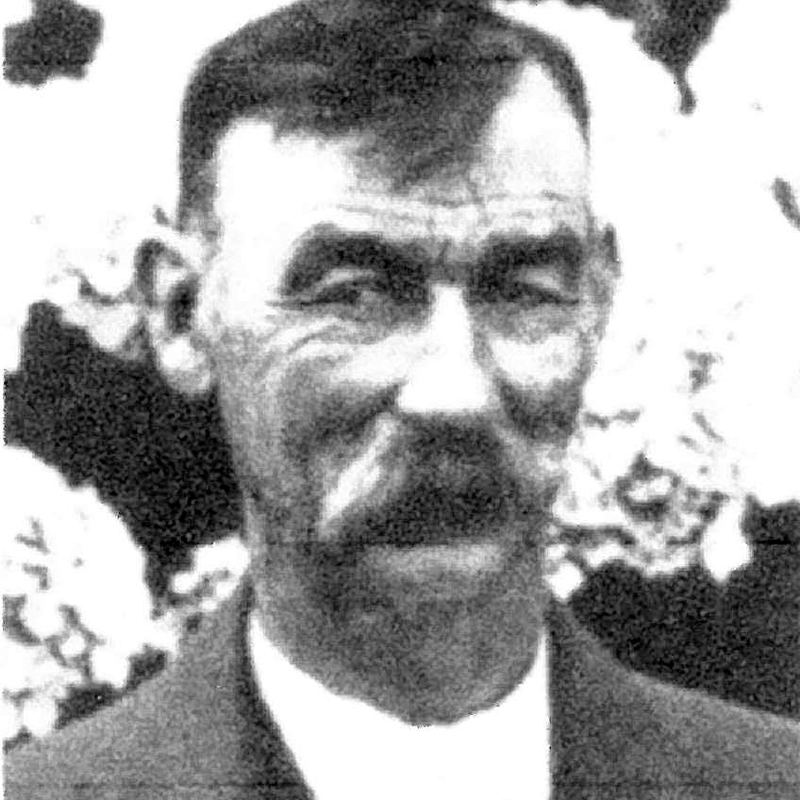
Johnny Meehan
The September 2022 edition of Peninsula Essence included “Buckley’s Chance”, the story of the legendary bush pilot from Benambra on the Omeo high plains. Ben Buckley was born in Hastings in 1936, and grew up on a dairy farm on the corner of Stumpy Gully and Myers Roads in Balnarring. In 2015, at the request of the Balnarring and District Historical Society, Ben recorded some recollections of his boyhood days.
He was a small lad during World War Two, but clearly remembered the “occupation’ of the area by the US in the early 1940’s when it was thought the Japanese might attack Australia from the south.
One of Ben’s stories told of the price paid by the US military in order to occupy Emu Plains Racecourse.
Sold for a crate of whiskey
“Both my dad, Jock Buckley, and Dick Audley were on the Racecourse Committee. I can remember riding with Dad, wedged between the two of them on the front seat of Dick’s old truck and Dick was telling Dad this story. The truck was one of those that had no side doors and a vertical windscreen with a shade projecting over it. He was telling the tale so vehemently and gesticulating so much that we were being edged further and further across the seat. I almost got hit by his flailing arm and I was scared Dad would fall out the passenger side.
The Americans had arrived in ships and were landed at either Dromana or Mornington and they rapidly moved across the Peninsula. The Emu Plains Racecourse was suddenly overwhelmed with military personnel who proceeded to set up camp. Local identity, Johnny Meehan, jumped in his Model A Ford and drove over to see what was happening. Johnny kept his finger on the pulse of the community; there wasn’t a civic or sports group that he wasn’t a member of. He reached the Racecourse well before any sort of order in the camp had been established. Amid all the flurry and activity of setting up camp Meehan asked to see whoever was in charge and was taken to the H.Q. tent. The C.O. was a Colonel Hadfield.
Meehan demanded to know what was going on. He started taking the Colonel to task for being on ‘his’ property and threatened to go to higher authorities. The Colonel tried to pacify him, not wanting to stir up trouble. He suggested to Meehan that maybe they could do a deal. “Certainly,” replied Meehan. He was invited to sit down around the ops. table to talk things out over a drink. The drink was whisky. Meehan suggested that a crate of whisky might seal the arrangement. He was offered a crate of Bourbon but he held out for a crate of Scotch. Done deal! Johnny Meehan drove away with the crate secured on the back tray of his Ford.
Dick Audley had a small orchard on Coolart Road opposite the Emu Plains Racecourse. He was either the president or secretary of the committee. He had noticed the military activity and went across to see what was going on. By then the Americans had settled in and there were guards on duty. He was escorted, under guard, to the Command H.Q. He explained his credentials and asked what was happening. Colonel Hadfield said, “You are standing on U.S. property. I’ve done a deal with Mr Meehan and this here is our property for the duration.” The Colonel also complained that it had cost him a crate of his best whisky.
Dick was pretty irate but he didn’t see any point in taking the matter any further. By now it was history and the Americans were there to stay.
As it was, the duration wasn’t very long. After a few months the Americans left as quickly as they had arrived. The expected Japanese invasion from the south was no longer considered a threat. After the Battle of the Coral Sea, General MacArthur wanted his troops elsewhere and Emu Plains was again public property. Johnny Meehan was left to enjoy his whisky and you can bet he didn’t share it around.”
By Terry Mulcahy
Acknowledgments:
Balnarring Picnic Racing Club acknowledges and thanks The Balnarring & District Historical Society as well as Bruce Bennett for the use of materials from Balnarring Byways Vol 1.





